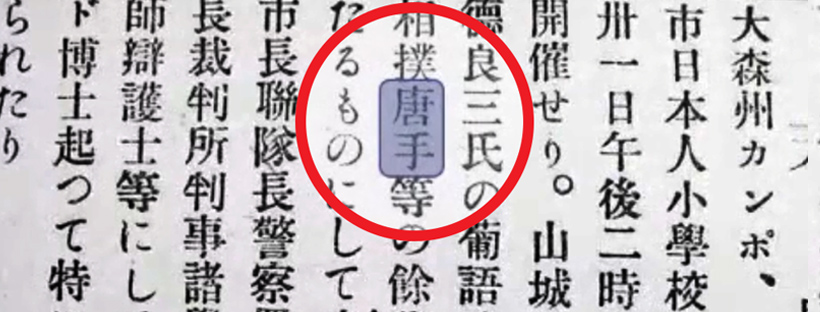The diverse collaborations of people interested in going deeper to preserve the history of martial arts, added together, generate fascinating results and expand the geral knowledge. When it comes to Karate in Brazil, this is also true: new details about the practice in the country emerge through these collaborations. Recently, I reflected on the beginnings of Karate in Brazil, talking a little about the first masters. Among them Motoku Yabiku, who, due to a 1951 video record, is the first known Karate teacher in Brazil. Yabiku arrived in the country in 1917, settling in the State of São Paulo, but there is no record (in the present moment) of him having openly practiced or taught Karate at that time.
It happens that when talking on Facebook about the information I have about Karate in Brazil, some people shared some details with me to expand this story. Among them, a fascinating discovery. On July 18, 2020, during a live on the Brazilian Kendo Confederation channel, Luiz Kobayashi Sensei *, a researcher and practitioner of the Japanese sword arts, presented a very rare historical record:
The November 14, 1919 edition of the extinct newspaper Brasil Jihô, of the Japanese colony in Brazil, talks about a presentation of martial arts in Brazil, on October 31 of the same year, in the city of Campo Grande, State of Mato Grosso do Sul… Among them was Karate with its old name, Tode (唐 手)!
In other words, Karate practiced outside Okinawa/Japan, in 1919, before the modernization of art and the creation of the styles practiced today.
There is no information on who gave this presentation, but this record in itself of great relevance, as it is the first of which there is news about the Karate/Tode being actually practiced in Brazil. Also it’s probably one of the first records of Karate/Tode being practiced outside Okinawa and Japanese territory. Of couse, okinawans immigrated to other places even before Brazil. For example to Hawaii, where apparently there are previous reports of the practice of Karate/Tode (if anyone has another, I would be happy to be informed).
Talking to Kobayashi Sensei, he commented to me that in this presentation described in the newspaper there was also a demonstration of “iron staff”. “Most likely, this was a weapon demonstration, which could also be a record of Okinawan Kobudo in Brazil.”
Below, I share an excerpt from the live video in which he comments on this historical record:
Thanks to the awesome Karate community, below I share a transcript and a translation of the newspaper’s text:
カンポ、グランデの天長節
大森州カンポ、グランデの同胞は同市日本人小學(学)校に於て日本晴の十月卅一(10/31)午後二時より天長節祝賀祭を開催せり。山城興昌 出利葉羊三 安里得良 三氏の葡語演説、撃剣 剣舞 鐵(鉄)棒 相撲 唐手 等の徐(余)興は大に人目を惹きたるものにして来賓の主なるものは市長 聯(連)隊長 警察署長 税務署長 新聞社長 裁判所判事 諸学校々長及び職員 醫(医)師 瓣(弁)護士 等にして中學(学)校々長アリンド博士起つて特に一場の祝辞を敍(述)べられたり
Kanji in ( ) are modern day equivalents.
———–
Emperor’s birthday celebration in Campo Grande.
Campo Grande brothers of Japan held the Emperor’s Birthday celebration on a beautiful sunny day of October 31st (10/31) 2:00 pm at the Japanese Elementary School. Three gentlemen, Mr. Kōshō Yamashiro, Mr. Yōzō Deriha and Mr. Tokuyoshi Asato gave speech in Portuguese. Audiences were very attracted to the programs such as Geki-ken (Kendō), Kembu (Sword dance), Iron bar, Sumo, Karate (Tōde), etc. Guests were Mayor, regimental commander, Police department Chief, Tax department Director, Newspaper President, Court Judge, School principals and Staffs, Medical doctors, Lawyers, etc. Especially, Junior High School principal, Dr. Arlindo, stood up and gave a congratulatery speech.
As Kobayashi Sensei says in the video, it is a difficult task to research further, but there are certainly more details to be highlighted. Contacting the Okinawan community in Campo Grande can be a good way, but there are certainly clues also in several other places where immigrants have settled. An example of this is that, in one of the posts I made about the first masters in Brazil, someone mentioned that he is doing research on the possible practice of Karate in a Japanese colony (koutakusseis) in the State of Amazonas, in the 1930s. I look forward to more information on this study and would be happy to pass it on. For my part, I intend to continue researching this and other topics related to the history of Karate and the technical scope of the art.
The more people engaged in this direction the better, in a serious and collaborative way, to add knowledge. This is the right way to elevate the Karate community in Brazil and in other parts of the world: keeping the spirit open for learning regardless of graduation, without letting the ego interfere when faced with new information, without underestimating the efforts of others and understanding that knowledge is in constant construction.
There is much that we do not yet know. And this is good, as we can continue to learn, improve and celebrate new discoveries.
* Luiz Kobayashi holds a PhD in engineering from the University of São Paulo and is a practitioner of traditional Japanese arts such as kendo, iaido, kenjutsu, iaijutsu, bôjutsu, kenbu and shibu. He is affiliated with Nihon Kobudô Shinkôkai, a Japanese organization for the preservation of traditional martial arts in Japan. In Japan, he received instructions directly from renowned masters of the arts mentioned above. He organized a personal library with transcripts of writings (some extremely rare), studies, compilations and discussions by Japanese experts on traditional martial arts, with an emphasis on Japanese fencing. He also works as a researcher on the history of kendo in Brazil, having texts published in several specialized magazines, such as Kendo Nippon and Kendo World. [source: Editora Estação Liberdade]
